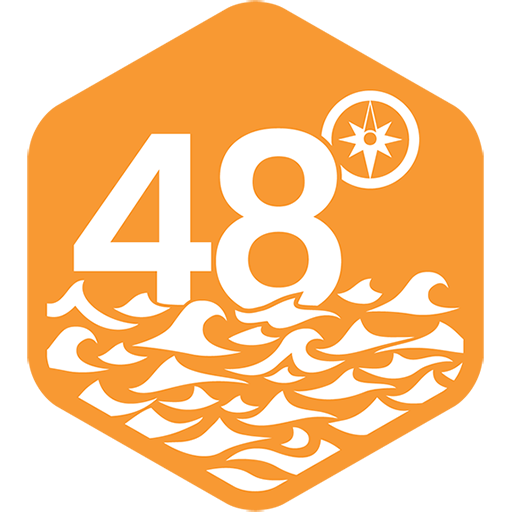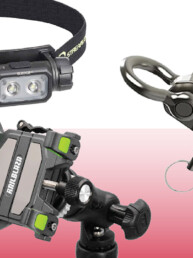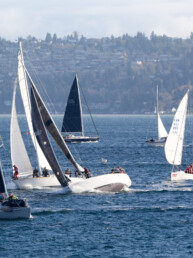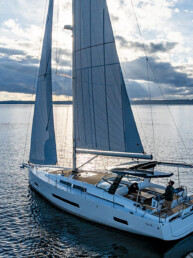Ah, that fresh salt air sweeping in gently across the surface of the Salish Sea. Whether you’re out for a pleasant sail on familiar waters or enjoying an adventurous voyage beyond the bounds of your known cruising universe, that sea air can relax you, transport you, and it can also make you hungry. How many cruisers can attest that food you enjoy on the water provides some of the most vivid memories of any journey? Lots. Most, probably. The company, the surroundings, the travel that led you there—they’re all ingredients in the sailing souffle, but without the food, there’s no meal to memorably share.
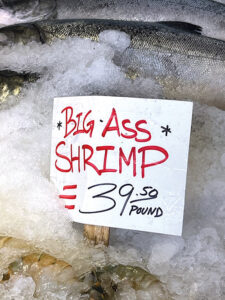
Solving salt-induced hunger and all that yummy fodder for rosy recollections doesn’t happen by accident. Whether you have spare crew to act as the sea-going cook or cooking is a shared utilitarian duty, there is an art to managing the galley and the grill, and thoughtful planning and preparation is a great investment.
Savvy mariners know that the variability between boats, cruising styles, and each boat’s equipment mean there’s never a one-size-fits-all approach in the galley, yet here are a few ideas to help the culinary aspects of cruising rise to the top of the fond memory bank. Also included are some fun ideas from my experience cooking and cruising our Cooper Seabird 37, as well as from a casual social media survey of some fellow Pacific Northwest boaters.
Stocking up
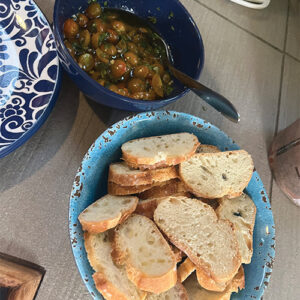
Much of your provisioning plan will depend on the confluence of the type of refrigeration you have available and the length of your trip. With a sizable fridge with a cold plate, you can load meat, cheese and other refrigerated items to stay fresh for days, or even weeks. Many coolers and ice boxes are more efficient now than ever. If your boat lacks refrigeration and a very wel- insulated ice box, it may be wise to bring a high-end rotomolded cooler aboard, many of which can retain ice for a week. Without any refrigeration, you might have to live off the land a bit more, visiting stores and farmers’ markets, gathering food to cook and eat that day or the next… or get really into dehydrated meals.
Whatever your cold-holding situation, it is useful to stock your galley with a few non-perishable staples: pasta, rice, canned beans, chili, soup, vegetables, tortilla chips, crackers and potato chips, as well as spices and cooking oil.
It’s good to be aware that food can often get funky more quickly on a boat than on land; spices especially can get stale and harden. However, having a few non-perishable items promises that even if you cannot add fresh meat or veggies, you won’t go hungry. There’s always mac and cheese, pasta with sauce, or Spam!
Appliances
Most boaters, especially those with vessels 30 feet and larger, have a propane-operated stove with at least two burners, and possibly three, which will be gimbaled for heeling on monohull sailboats. With that setup in place, you can cook a protein (beef, fish, chicken, etc.) on one of the burners while boiling, sautéing, or otherwise preparing pasta, vegetables, or potatoes on another available burner. People often fear planning out traditional meal preparation on a (relatively) small propane stove, especially if they are accustomed to the four to six-burner stoves of a more modern kitchen on land. But in reality, how many burners and how much space do you really need?
If you are inclined, setting up your galley with a small blender (Ninja, Bullet, or something similar) can come in handy for the folks who want to drink a meal or two in the form of a smoothie or iced beverage—especially if they’re taking advantage of the fresh fruit that is often available at various farmers’ markets and stores throughout Puget Sound.
Installing a small microwave, or microwave with a convection oven, offers a useful option to reheat leftovers or aid in meal preparation, though you’re mostly likely to need AC power to run such a power-hungry device. Propane is relatively cheap and efficient, but going through the motions to top up your tank(s) may be enough to drive you to be creative. Accordingly, many boaters like to use a pressure cooker to save propane by cooking things more quickly, or electric devices like a crockpot or electric skillet.
Of course, whatever your cabin galley setup, the stern-rail barbecue is a fan favorite among the majority of cruisers. There are various models, but the principles are pretty universal—as is the popularity of the grub coming off of them. Though many are setup out of the box to employ single-use propane canisters, the environmentally conscious boater—and as enthusiasts of fragile marine ecosystems, that’s most of us—may want to consider a reusable option of some kind or plumbing the grill right to the main propane tank. If you have been cruising without a grill, adding one to your stern pulpit is sure to be your best cruising decision this summer.
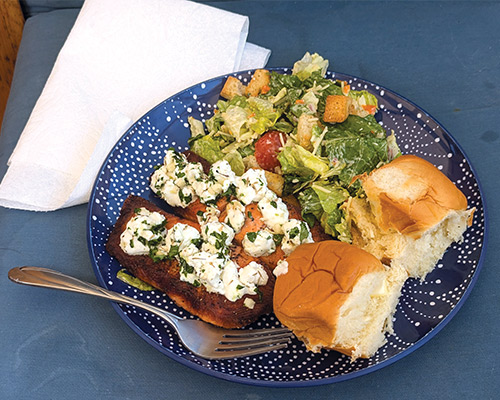
Ingredients
As at home, making meals is typically a combination of utilizing fresh and non-perishable items. On the boat, I like to stock my galley with pasta, pasta sauce, canned chili, tinned clams, canned tuna or salmon, crackers and/or chips, olive oil and canola oil, balsamic vinegar, condiments, commonly used spices, preferred beverages, and Spam (if that’s your thing—it’s my husband’s but not mine).
Starting off with a cavalcade of staples, it becomes easier to plug in perishable items—from veggies to meats, cheeses and fruits—when you’re ready to sail. Like many cooks, I try to work with vegetables and fruits that are in season, and searching for these fruits at cruising stopovers along the way becomes equal parts fun scavenger hunt and voyage of discovery at any new-to-us destination. Oftentimes at these new or sometimes foreign ports, you may find your way to local vegetables, fruit, fish and meat, as well local seasonings and sides. Don’t pass up these unique opportunities.
More often than not, we are headed out for a simple long weekend on the Sound. As much as we absolutely love these little jaunts, there aren’t always exotic culinary finds around every corner. As such, I usually plan the meals we might want to eat aboard, but my personal hack is to pack surprise extras. Maybe we’ve decided we’ll grill burgers one night—pre-making some complementary German potato salad, and throwing in a few ears of corn as well as ingredients for a seasonal salad will take one of the more basic menus from ho-hum to a “remember when” feast afloat.
Of course, there is too much of a good thing. Thoughtful planning will ensure that you’ll not only “eat hearty” but you’ll hopefully avoid wasting precious perishables. The point, like so many in cruising, is a delicate balance between thorough preparation and up-to-the-minute adaptability to take advantage of the best version of underway unexpecteds.
Suggestions from Fellow Boaters
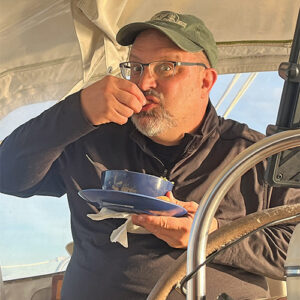
like Spam, but he’ll gladly take some
delicious haute cuisine in the cockpit as well.
Getting excited about not only writing this article, but cooking while cruising this season, I threw an open-ended question about cooking habits out to some local boating groups on social media, and the response was rather overwhelming. Here are a few of those ideas.
Bruce from Puget Sound Boating: “We use a deep electric fry pan for steaming crab in the cockpit or even on the swim step. [The directions are simple, add one] 1/2 inch of sea water and put them in when the water starts to boil; set timer for 15 minutes; remove and cool crab halves with cool sea water—two or three dunks. Then we use the crack and snap method to get the meat out. You can kill the crab before you cook it, which we have done as a family since 1953 near Roche Harbor. Grab the left legs with left hand, right legs with right hand, find a protruding stationary rock or cleat, smash the chest area on the solid thing and quickly break crab in half, top big shell comes flying off, guts spray out, rinse carcass in salt water then cook.”
Lea from Cooking on a Boat: “Nearly 40 years liveaboard and we have always kept it simple. No power-hungry appliances, and a cordless drill as a mixer. I love baking and Asian stir-fries and curries are a regular.”
Mike from Puget Sound Boating: “Our favorite pots for the galley are the Sea to Summit brand collapsible silicone cooking pots in three sizes ranging from 1 liter to 4 liters. They all have a strainer built into the lid for easy draining, and they all fit inside each other when collapsed. We love how little space they take up in our limited galley storage. We also really like the OXO Silicone Good Grips flexible turner and mixing spoon. Both these pots and utensils are so loved compared to setups we’ve used in the past that we keep a set on the boat and a set for our camp kitchen when we’re on land. We usually stop and pick up some Annie’s Mac & Cheese mix, Aidells sausages and shredded cheese. Then we stop at the farmers’ market either in Eastsound on Orcas Island or in Friday Harbor on San Juan Island to pick up fresh elephant kale, bell peppers, and mushrooms. If we miss the markets we can get this stuff at the local grocery, but we try to time it with the farmer market. We make the Mac & Cheese kit in our collapsible pot, grill the sausage, add kale, bell pepper, mushrooms, and real cheese. Mix it all together until you achieve your desired cheesy goodness. Serve and enjoy with a beverage of choice, and a sunset view off the aft deck.”
Beth from Puget Sound Boating: “Last summer, I purchased an induction burner and it works amazingly for cooking clams and crab on the swim step or dock. I have several collapsible cooking dishes that I love. My crockpot is a favorite, especially when we have a long run.”
Gene from Puget Sound Boating: “I have a propane oven with a three burner cooktop. I also have a small BBQ. I cook the same as I did when I was on land. The same food, and desserts. I use a good set of pots and pans, and I have never had any issues.”
Diana from Cooking on a Boat: “Do not cook naked.”
Wrap Up
Well, that’s some food for thought for making meals while cruising. Have fun planning and cooking. It doesn’t take much for your boat food to be a real highlight of your next cruise!
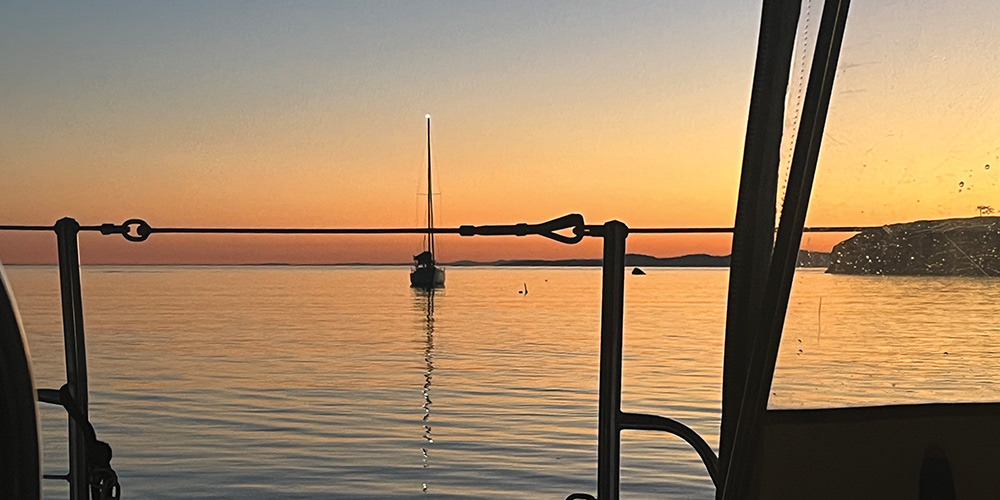
Karen “Pepper” Hoffman has been boating on Puget Sound for nearly a decade, with her husband Alan and at least one furry (canine) first mate. While she admittedly still has a lot to learn about sailing, she’s quite the salty dog when it comes cooking and baking. She feels most at home when she’s on the water—be it in a guest slip visiting Friday Harbor or Anacortes, at anchor in a quiet sheltered bay, or just hanging out on her Cooper Seabird Yardbird at her own home port.
